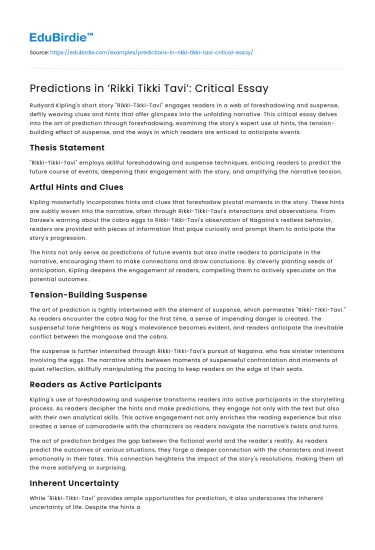Rudyard Kipling's short story "Rikki-Tikki-Tavi" engages readers in a web of foreshadowing and suspense, deftly weaving clues and hints that offer glimpses into the unfolding narrative. This critical essay delves into the art of prediction through foreshadowing, examining the story's expert use of hints, the tension-building effect of suspense, and the ways in which readers are enticed to anticipate events.
Thesis Statement
"Rikki-Tikki-Tavi" employs skillful foreshadowing and suspense techniques, enticing readers to predict the future course of events, deepening their engagement with the story, and amplifying the narrative tension.
Save your time!
We can take care of your essay
- Proper editing and formatting
- Free revision, title page, and bibliography
- Flexible prices and money-back guarantee
Artful Hints and Clues
Kipling masterfully incorporates hints and clues that foreshadow pivotal moments in the story. These hints are subtly woven into the narrative, often through Rikki-Tikki-Tavi's interactions and observations. From Darzee's warning about the cobra eggs to Rikki-Tikki-Tavi's observation of Nagaina's restless behavior, readers are provided with pieces of information that pique curiosity and prompt them to anticipate the story's progression.
The hints not only serve as predictions of future events but also invite readers to participate in the narrative, encouraging them to make connections and draw conclusions. By cleverly planting seeds of anticipation, Kipling deepens the engagement of readers, compelling them to actively speculate on the potential outcomes.
Tension-Building Suspense
The art of prediction is tightly intertwined with the element of suspense, which permeates "Rikki-Tikki-Tavi." As readers encounter the cobra Nag for the first time, a sense of impending danger is created. The suspenseful tone heightens as Nag's malevolence becomes evident, and readers anticipate the inevitable conflict between the mongoose and the cobra.
The suspense is further intensified through Rikki-Tikki-Tavi's pursuit of Nagaina, who has sinister intentions involving the eggs. The narrative shifts between moments of suspenseful confrontation and moments of quiet reflection, skillfully manipulating the pacing to keep readers on the edge of their seats.
Readers as Active Participants
Kipling's use of foreshadowing and suspense transforms readers into active participants in the storytelling process. As readers decipher the hints and make predictions, they engage not only with the text but also with their own analytical skills. This active engagement not only enriches the reading experience but also creates a sense of camaraderie with the characters as readers navigate the narrative's twists and turns.
The act of prediction bridges the gap between the fictional world and the reader's reality. As readers predict the outcomes of various situations, they forge a deeper connection with the characters and invest emotionally in their fates. This connection heightens the impact of the story's resolutions, making them all the more satisfying or surprising.
Inherent Uncertainty
While "Rikki-Tikki-Tavi" provides ample opportunities for prediction, it also underscores the inherent uncertainty of life. Despite the hints and foreshadowing, the story introduces unexpected elements that challenge readers' predictions. Nagaina's desperate attempt to escape with one egg, for example, surprises readers who might have predicted a different resolution.
Kipling's narrative choices remind readers that life, like the story, remains unpredictable. This unpredictability serves as a reminder of the complexity of the natural world, where even the most astute predictions may be challenged by unforeseen circumstances.
Conclusion
In "Rikki-Tikki-Tavi," Rudyard Kipling demonstrates his masterful command of foreshadowing and suspense, artfully engaging readers in the act of prediction. By skillfully planting hints and fostering a sense of suspense, he creates a reading experience that transcends the page and invites readers to actively participate in the narrative's evolution.
Through their predictions, readers become more than mere observers—they become co-creators of the story's unfolding. The engagement with foreshadowing and suspense elevates the reading experience, deepening the emotional connection with the characters and intensifying the impact of the narrative's resolutions. "Rikki-Tikki-Tavi" not only captures the art of prediction but also reminds us that even in a world where predictions can be made, life remains a tapestry woven with threads of uncertainty, surprise, and the thrill of the unknown.






 Stuck on your essay?
Stuck on your essay?

